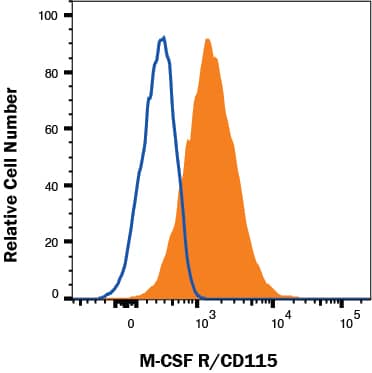Human M-CSF R/CD115 Antibody Summary
rhGM-CSF R beta.
Ile20-Glu512 (Pro54Ala)
Accession # P07333.2
*Small pack size (-SP) is supplied either lyophilized or as a 0.2 µm filtered solution in PBS.
Applications
Please Note: Optimal dilutions should be determined by each laboratory for each application. General Protocols are available in the Technical Information section on our website.
Scientific Data
 View Larger
View Larger
Detection of M-CSF R/CD115 in THP-1 cells by Flow Cytometry THP-1 cells were stained with Mouse Anti-Human M-CSF R/CD115 Monoclonal Antibody (Catalog # MAB329, filled histogram) or isotype control antibody (Catalog # MAB002, open histogram) followed by Allophycocyanin-conjugated Anti-Mouse IgG Secondary Antibody (Catalog # F0101B). View our protocol for Staining Membrane-associated Proteins.
Reconstitution Calculator
Preparation and Storage
- 12 months from date of receipt, -20 to -70 °C as supplied.
- 1 month, 2 to 8 °C under sterile conditions after reconstitution.
- 6 months, -20 to -70 °C under sterile conditions after reconstitution.
Background: M-CSF R/CD115
M-CSF receptor, the product of the c-fms proto-oncogene, is a member of the type III subfamily of receptor tyrosine kinases that also includes receptors for SCF and PDGF. These receptors each contain five immunoglobulin-like domains in their extracellular domain (ECD) and a split kinase domain in their intracellular region (1‑4). M-CSF receptor is expressed primarily on cells of the monocyte/macrophage lineage, dendritic cells, stem cells and in the developing placenta (1). Human M-CSF receptor cDNA encodes a 972 amino acid (aa) type I membrane protein with a 19 aa signal peptide, a 493 aa extracellular region containing the ligand-binding domain, a 25 aa transmembrane domain, and a 435 aa cytoplasmic domain. The human M-CSF R ECD shares 60%, 64%, 72%, 75%, 75%, and 76% aa identity with mouse, rat, bovine, canine, feline, and equine M-CSF R, respectively. Activators of protein kinase C induce TACE/ADAM17 cleavage of the M-CSF receptor, releasing the functional ligand-binding extracellular domain (5). M-CSF binding induces receptor homodimerization, resulting in transphosphorylation of specific cytoplasmic tyrosine residues and signal transduction (6). The intracellular domain of activated M-CSF R binds more than 150 proteins that affect cell proliferation, survival, differentiation and cytoskeletal reorganization. Among these, PI3Kinase, P42/44 ERK, and c-Cbl are key transducers of M-CSF R signals (3, 4). M-CSF R engagement is continuously required for macrophage survival and regulates lineage decisions and maturation of monocytes, macrophages, osteoclasts and DC (3, 4). M-CSF R and integrin alpha v beta 3 share signaling pathways during osteoclastogenesis and deletion of either causes osteopetrosis (7, 8). In the brain, microglia expressing increased M-CSF R are concentrated with Alzheimers a beta peptide, but their role in pathogenesis is unclear (9, 10).
- deParseval, N. et al. (1993) Nucleic Acids Res. 21:750.
- Rothwell, V.M. and L.R. Rohrschneider (1987) Oncogene Res. 1:311.
- Chitu, V. and E.R. Stanley (2006) Curr. Opin. Immunol. 18:39.
- Ross, F.P. and S.L. Teitelbaum (2005) Immunol. Rev. 208:88.
- Rovida, E. et al. (2001) J. Immunol. 166:1583.
- Yeung, Y. et al. (1998) J. Biol. Chem. 273:17128.
- Dai, X. et al. (2002) Blood 99:111.
- Faccio, R. et al. (2003) J. Clin. Invest. 111:749.
- Li, M. et al. (2004) J. Neurochem. 91:623.
- Mitrasinovic, O.M. et al. (2005) J. Neurosci. 25:4442.
Product Datasheets
Citations for Human M-CSF R/CD115 Antibody
R&D Systems personnel manually curate a database that contains references using R&D Systems products. The data collected includes not only links to publications in PubMed, but also provides information about sample types, species, and experimental conditions.
6
Citations: Showing 1 - 6
Filter your results:
Filter by:
-
An adapted protocol to derive microglia from stem cells and its application in the study of CSF1R-related disorders
Authors: Dorion, MF;Casas, D;Shlaifer, I;Yaqubi, M;Fleming, P;Karpilovsky, N;Chen, CX;Nicouleau, M;Piscopo, VEC;MacDougall, EJ;Alluli, A;Goldsmith, TM;Schneider, A;Dorion, S;Aprahamian, N;MacDonald, A;Thomas, RA;Dudley, RWR;Hall, JA;Fon, EA;Antel, JP;Stratton, JA;Durcan, TM;La Piana, R;Healy, LM;
Molecular neurodegeneration
Species: Human
Sample Types: Whole Cells, Transfected Whole Cells
Applications: Flow Cytometry -
Imatinib and Nilotinib Off-Target Effects on Human NK Cells, Monocytes, and M2 Macrophages
Authors: F Bellora, A Dondero, MV Corrias, B Casu, S Regis, F Caliendo, A Moretta, M Cazzola, C Elena, L Vinti, F Locatelli, C Bottino, R Castriconi
J. Immunol., 2017-07-12;0(0):.
Species: Human
Sample Types: Whole Cells
Applications: Flow Cytometry -
Direct inhibition of human RANK+ osteoclast precursors identifies a homeostatic function of IL-1beta.
Authors: Lee B, Kim TH, Jun JB, Yoo DH, Woo JH, Choi SJ, Lee YH, Song GG, Sohn J, Park-Min KH, Ivashkiv LB, Ji JD
J. Immunol., 2010-10-08;185(10):5926-34.
Species: Human
Sample Types: Whole Cells
Applications: Flow Cytometry -
Resistance of acute myeloid leukemic cells to the triterpenoid CDDO-Imidazolide is associated with low caspase-8 and FADD levels.
Authors: Riccioni R, Senese M, Diverio D, Riti V, Mariani G, Boe A, LoCoco F, Foa R, Peschle C, Sporn M, Testa U
Leuk. Res., 2008-03-04;32(8):1244-58.
Species: Human
Sample Types: Whole Cells
Applications: Flow Cytometry -
Expression of Tie-2 and other receptors for endothelial growth factors in acute myeloid leukemias is associated with monocytic features of leukemic blasts.
Authors: Riccioni R, Diverio D, Mariani G, Buffolino S, Riti V, Saulle E, Petrucci E, Cedrone M, Lo-Coco F, Foa R, Peschle C, Testa U
Stem Cells, 2007-04-19;25(8):1862-71.
Species: Human
Sample Types: Whole Cells
Applications: Flow Cytometry -
Serotonin 5-HT2C Receptor Cys23Ser Single Nucleotide Polymorphism Associates with Receptor Function and Localization In Vitro
Authors: Michelle A. Land, Holly L. Chapman, Brionna D. Davis-Reyes, Daniel E. Felsing, John A. Allen, F. Gerard Moeller et al.
Scientific Reports
FAQs
No product specific FAQs exist for this product, however you may
View all Antibody FAQsReviews for Human M-CSF R/CD115 Antibody
There are currently no reviews for this product. Be the first to review Human M-CSF R/CD115 Antibody and earn rewards!
Have you used Human M-CSF R/CD115 Antibody?
Submit a review and receive an Amazon gift card.
$25/€18/£15/$25CAN/¥75 Yuan/¥2500 Yen for a review with an image
$10/€7/£6/$10 CAD/¥70 Yuan/¥1110 Yen for a review without an image

